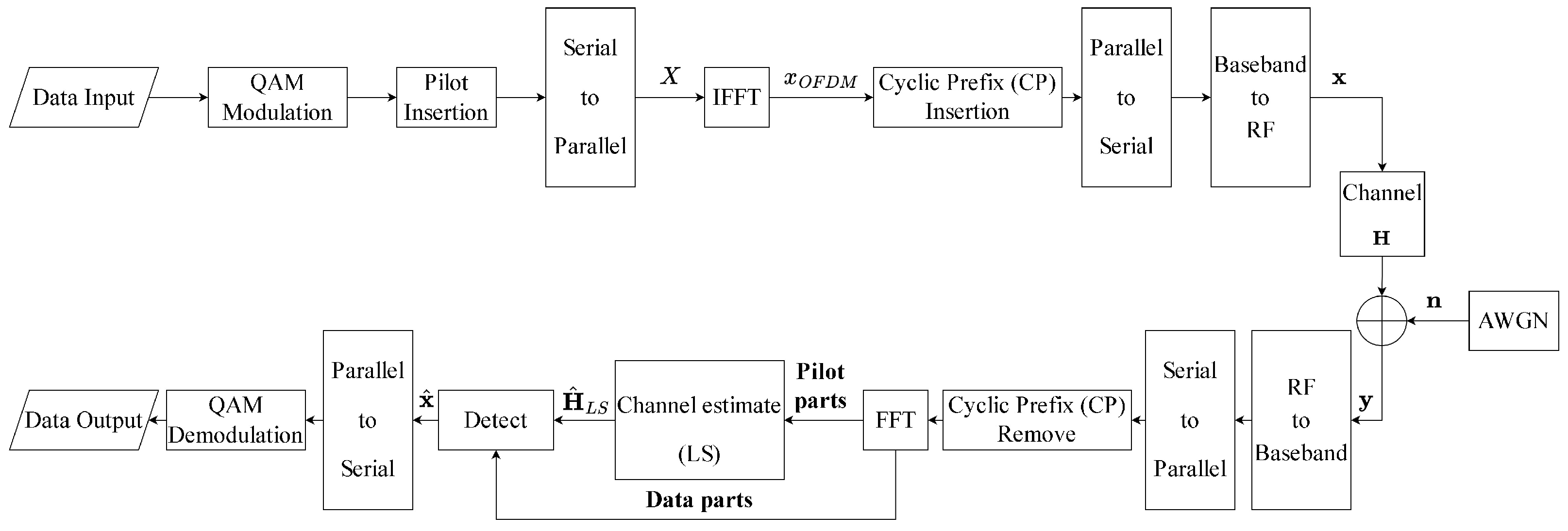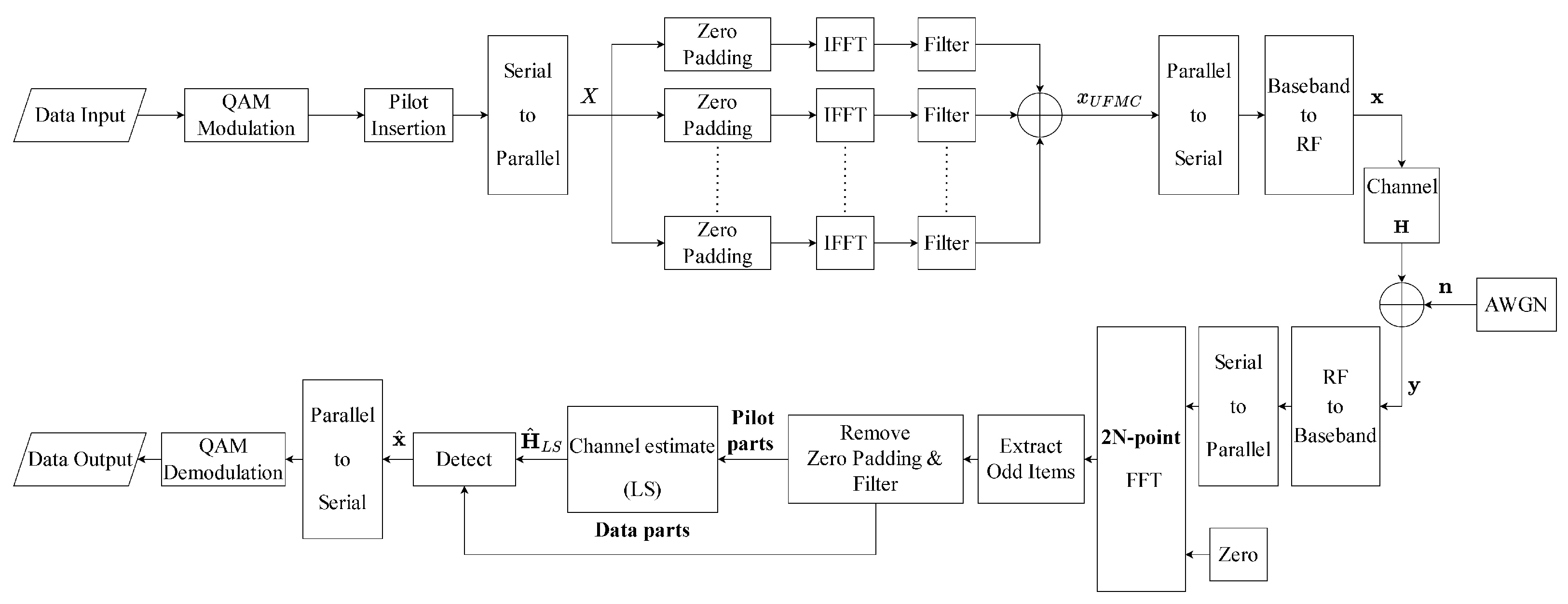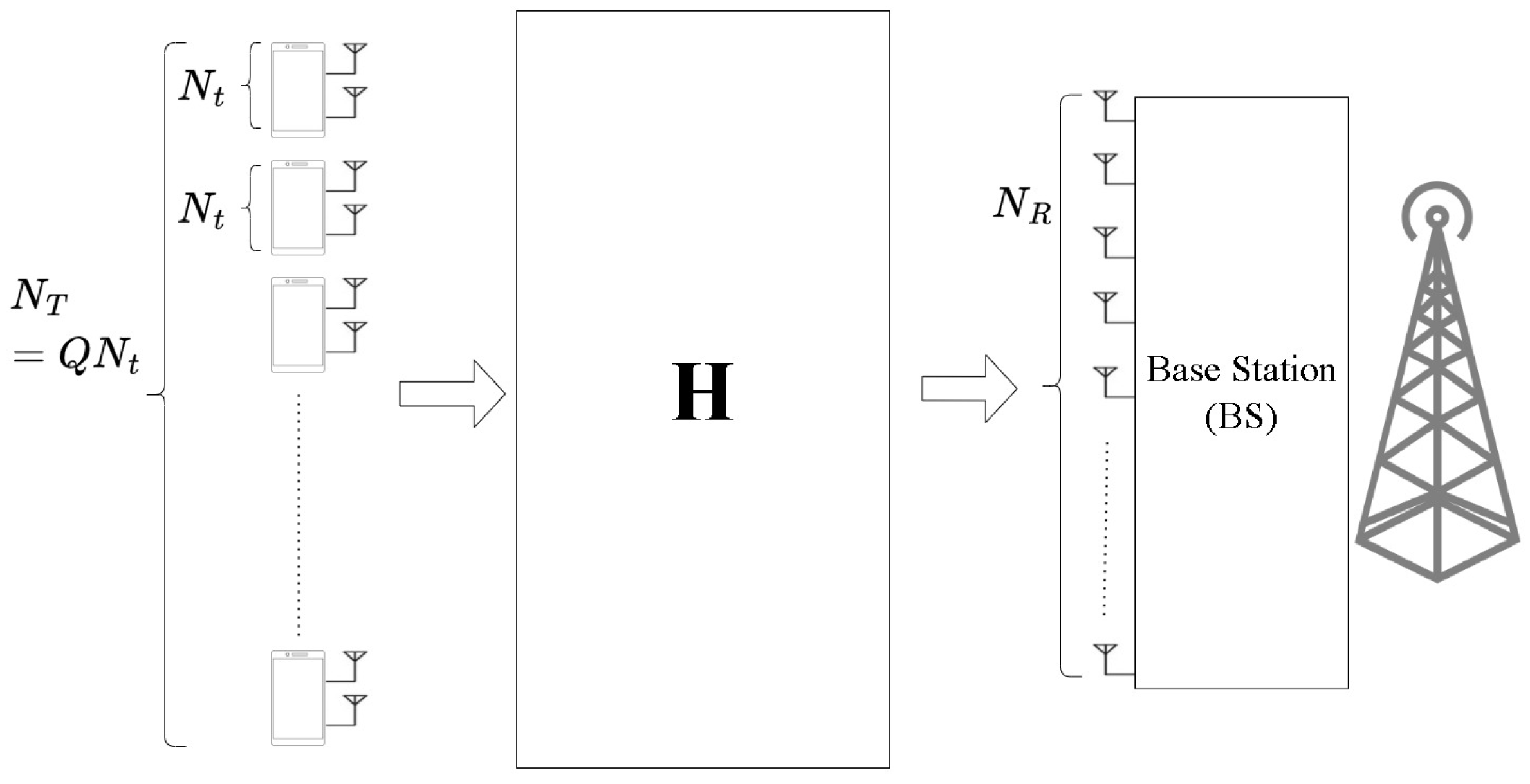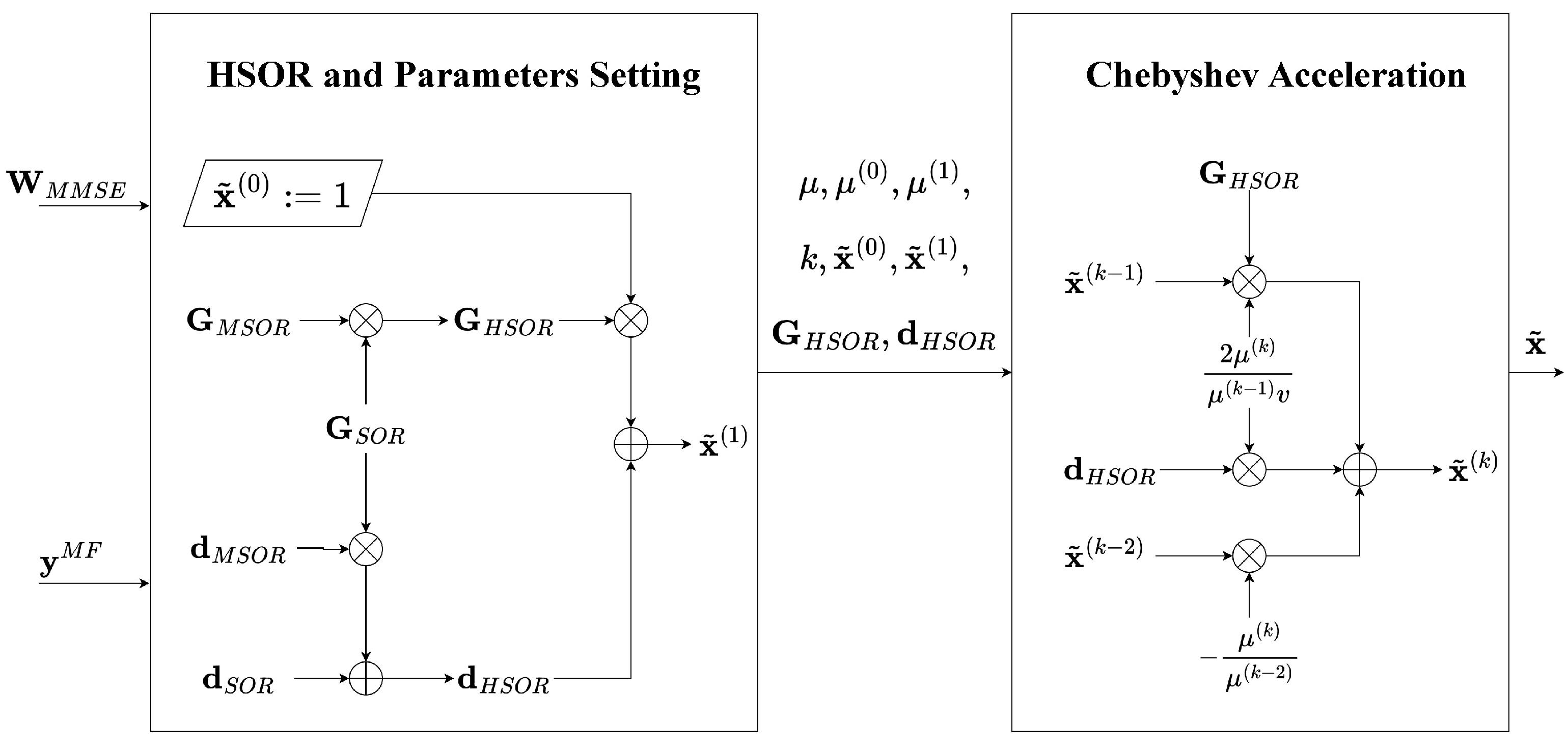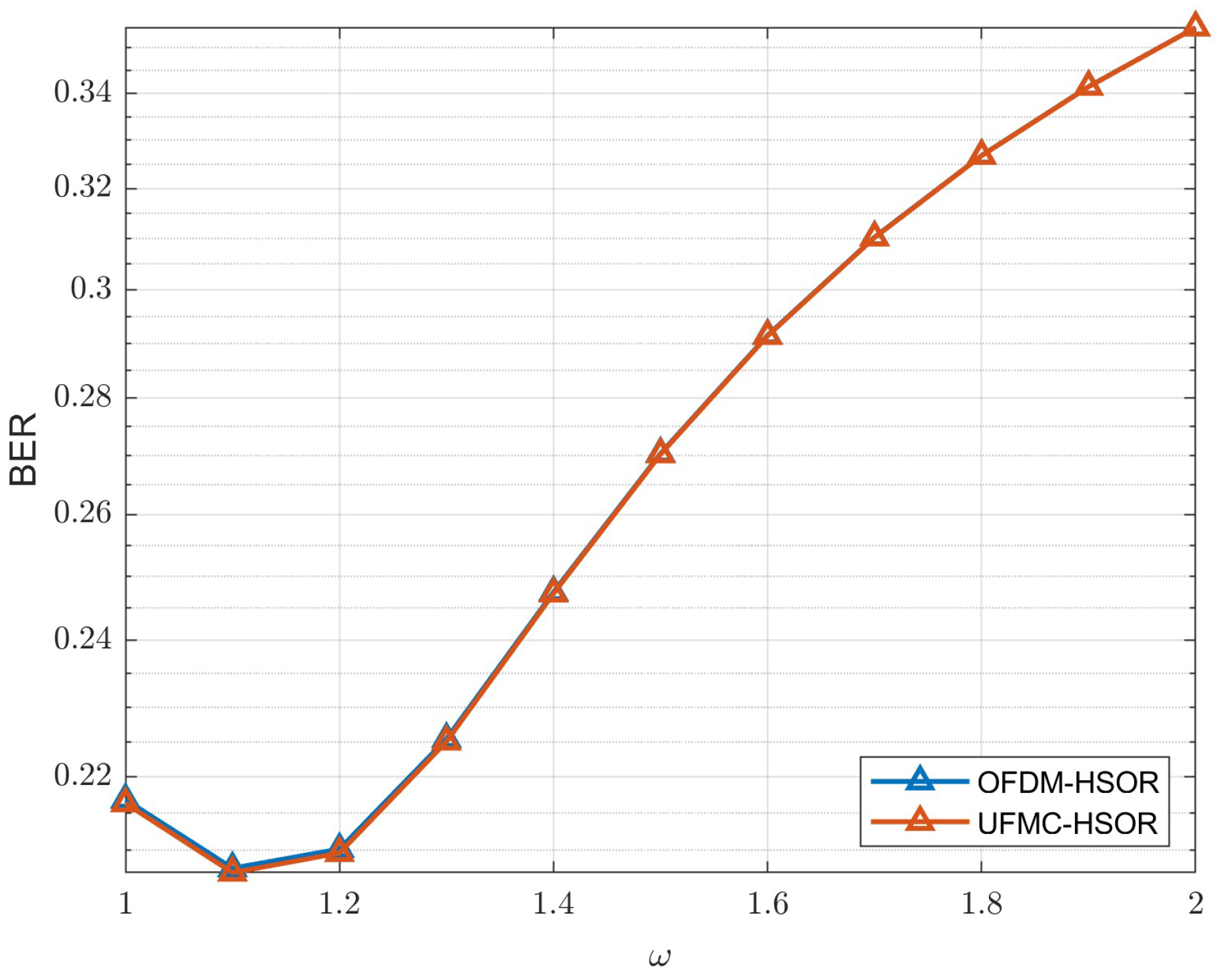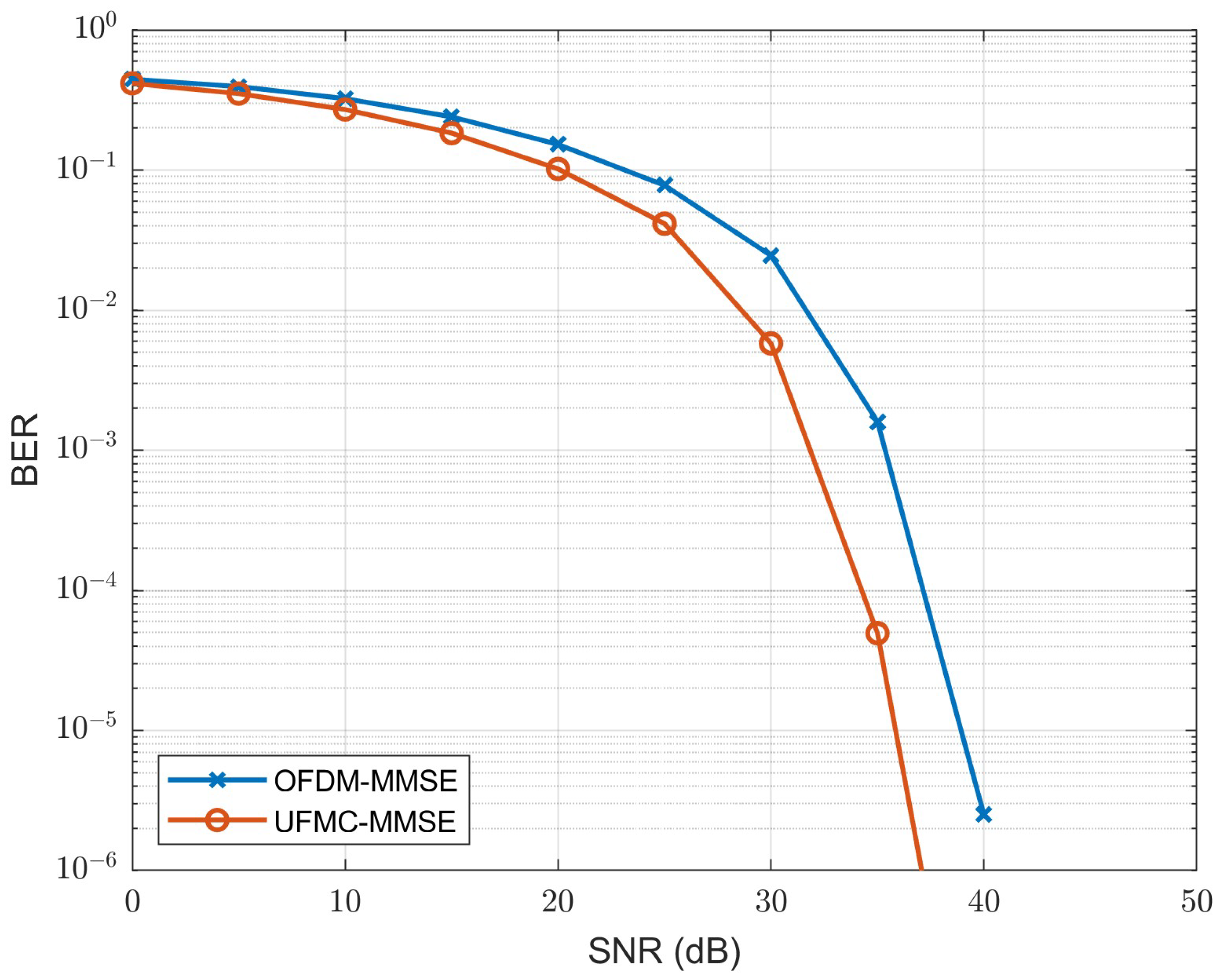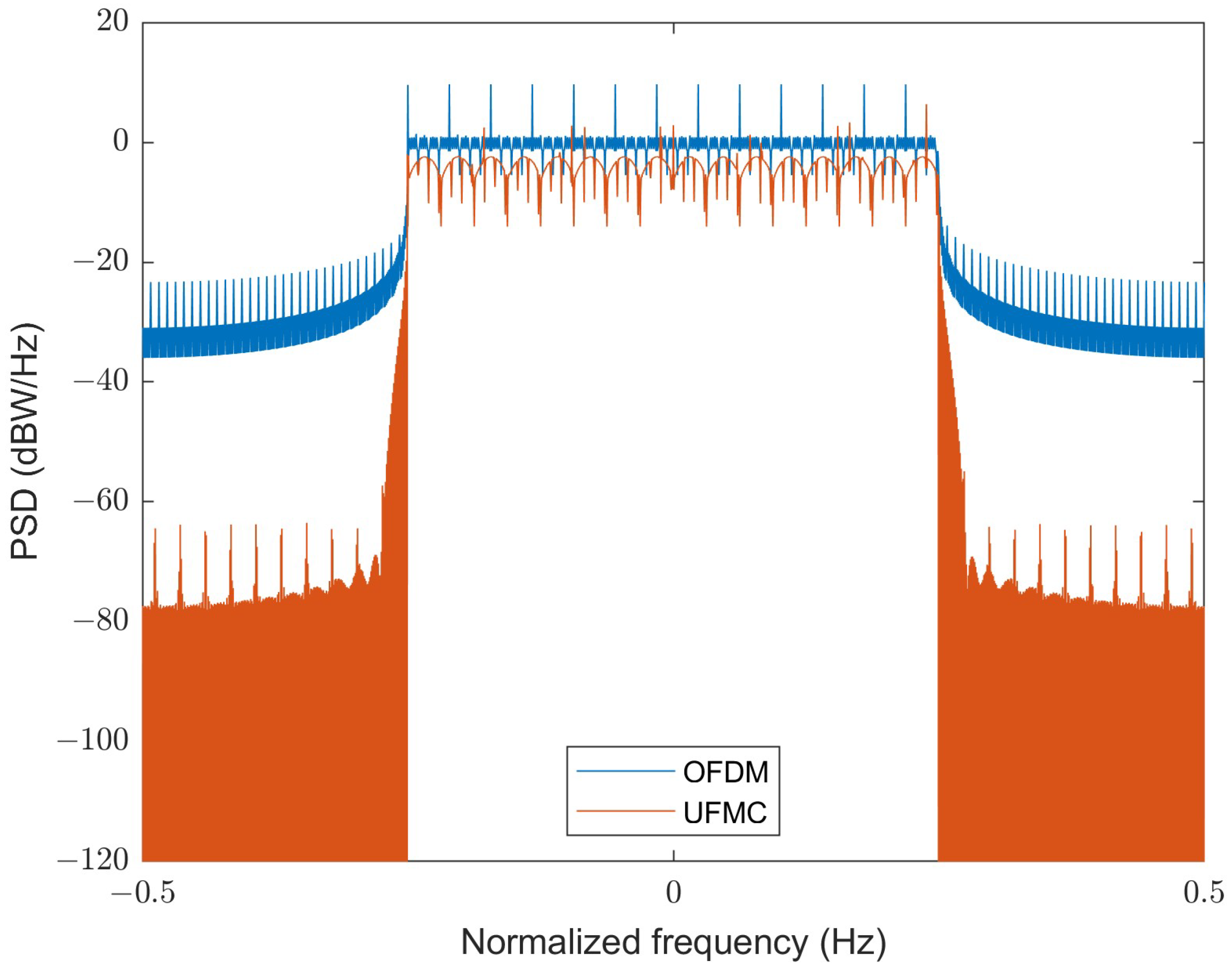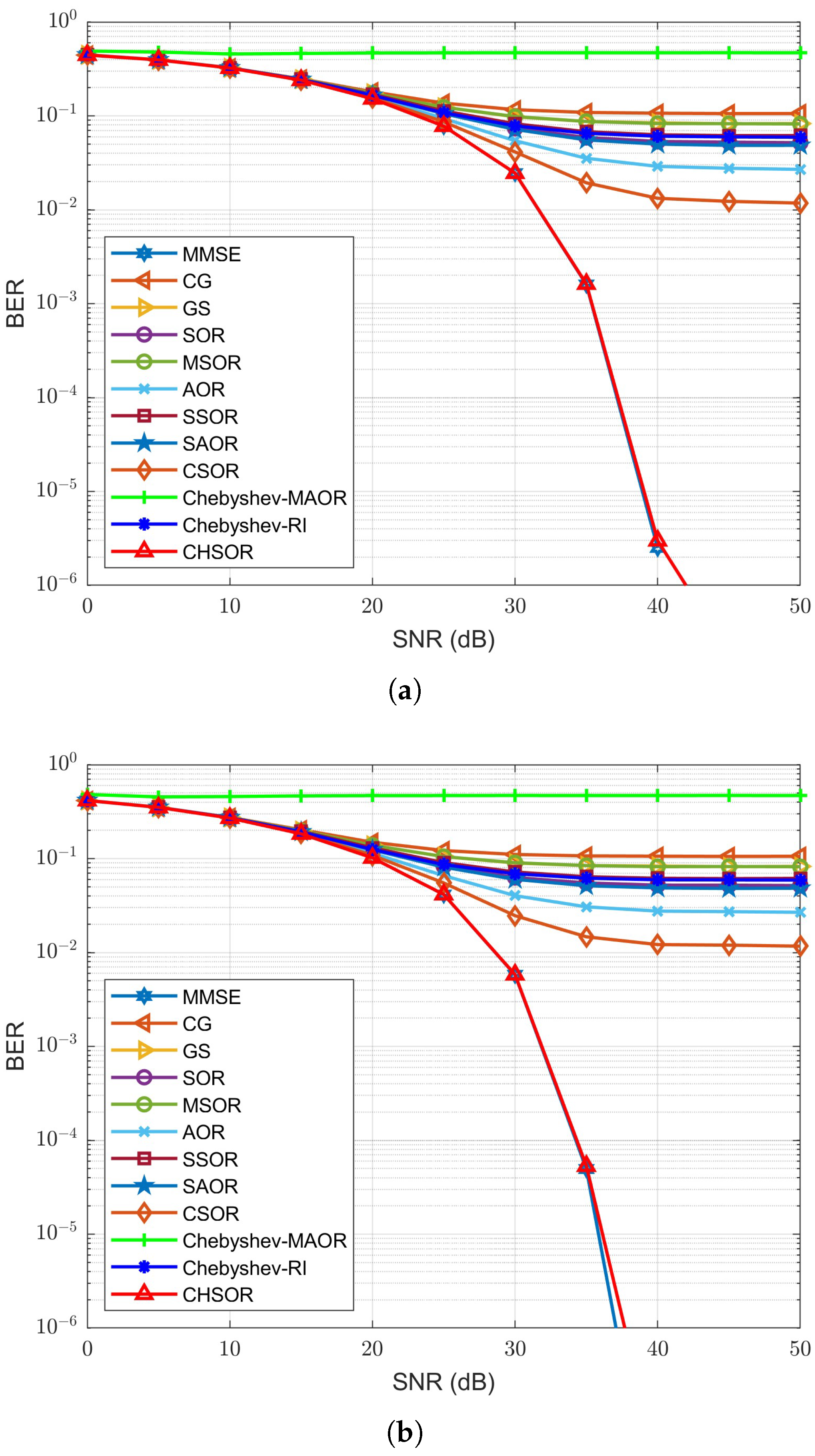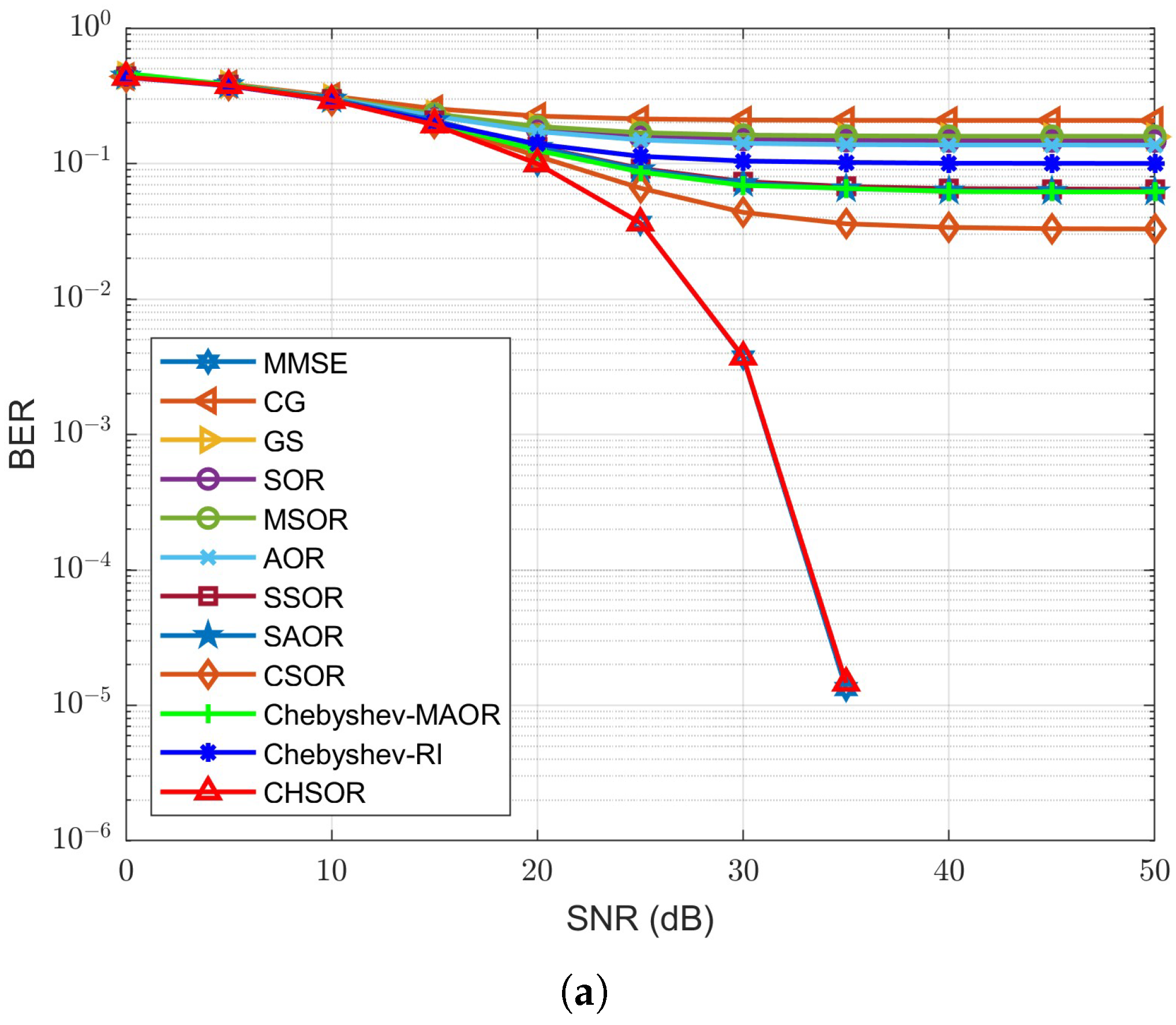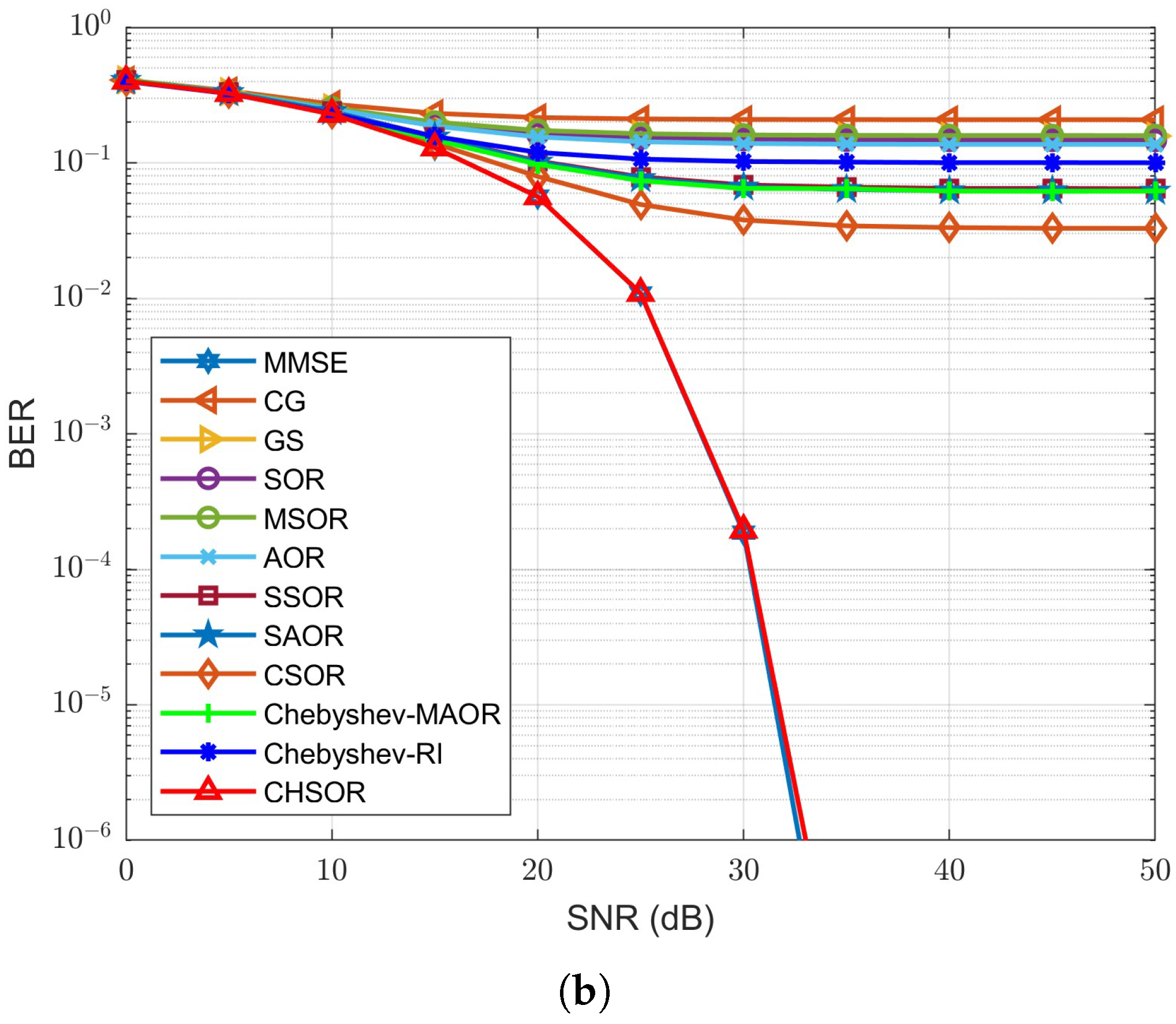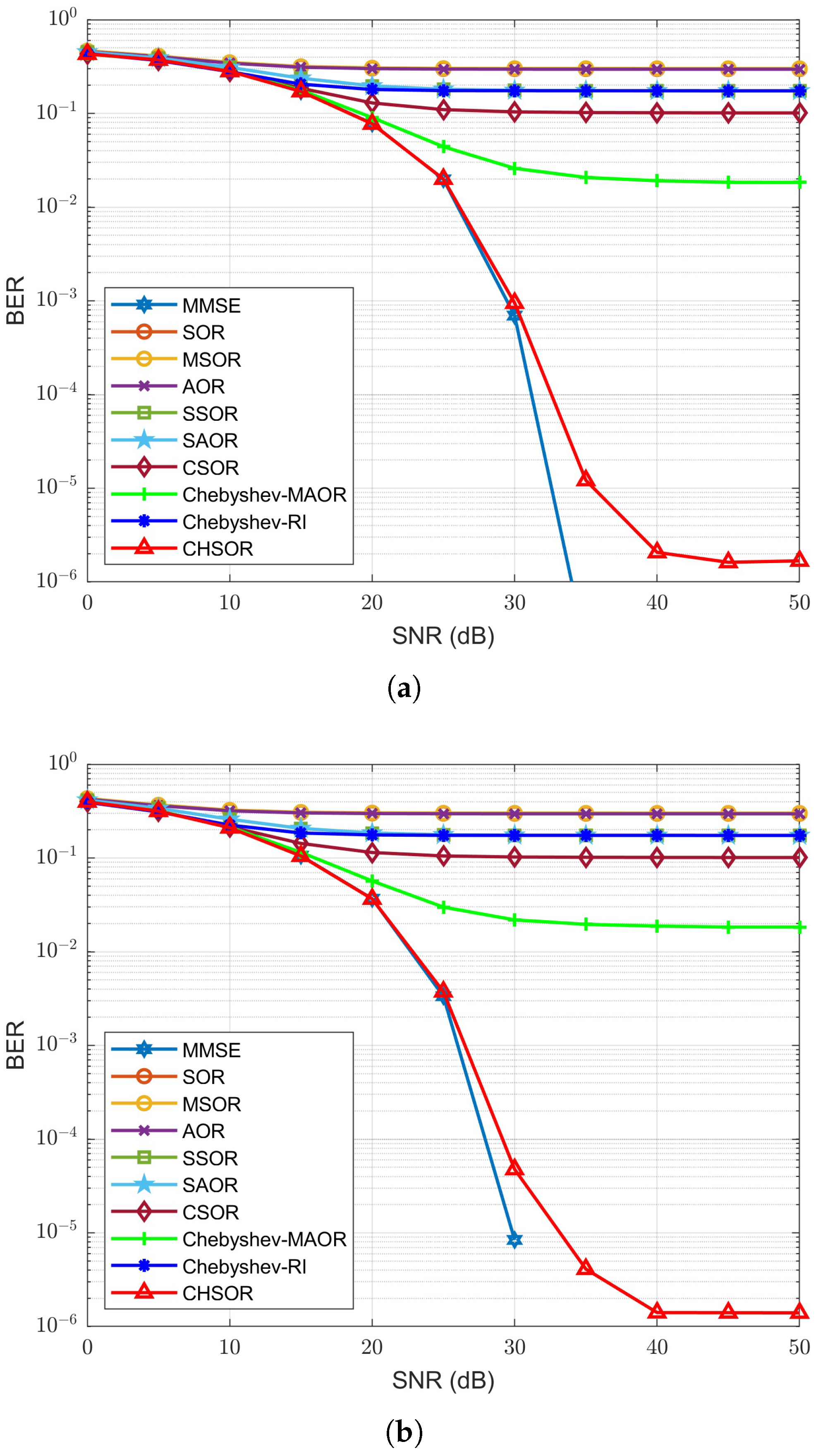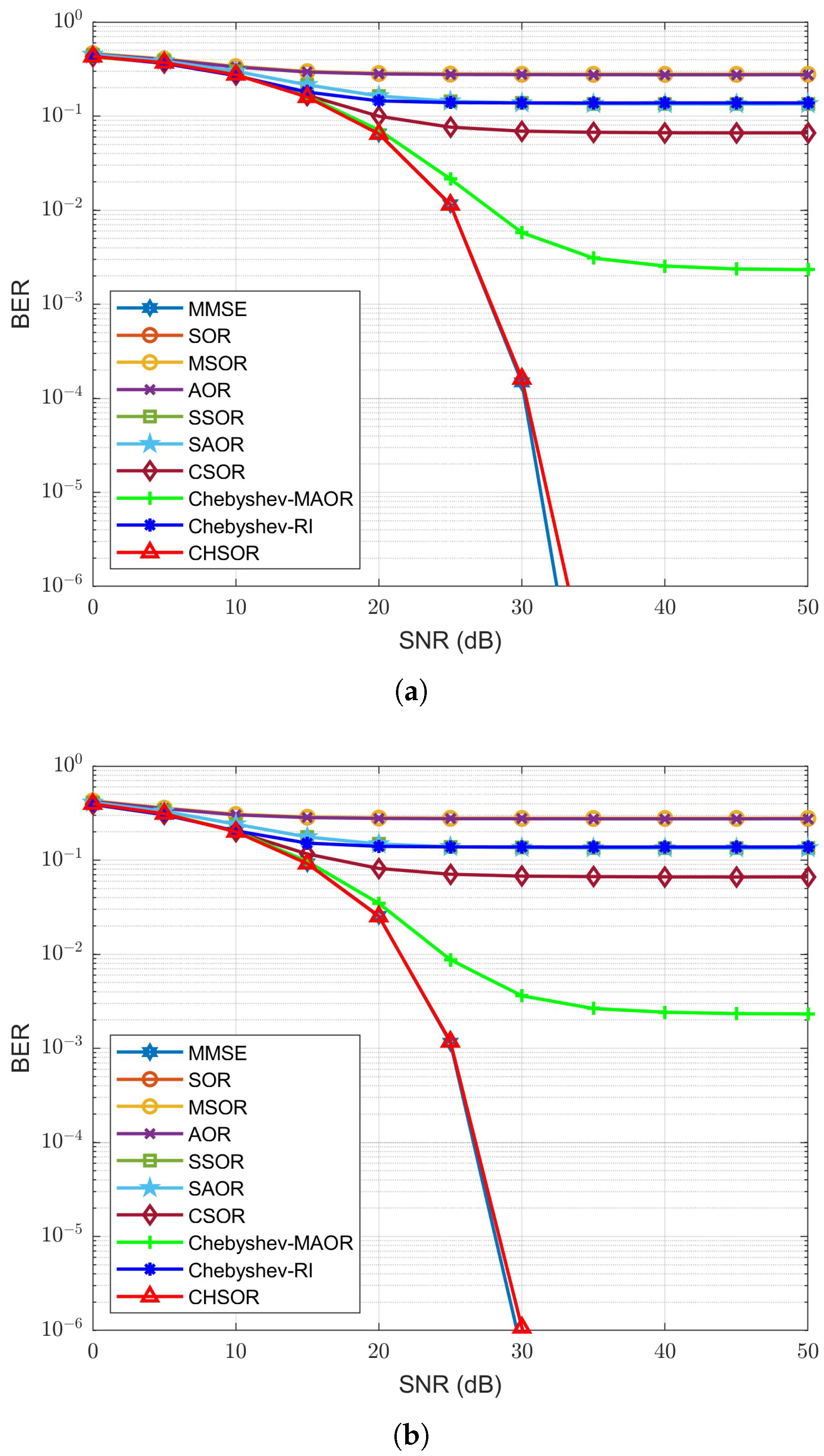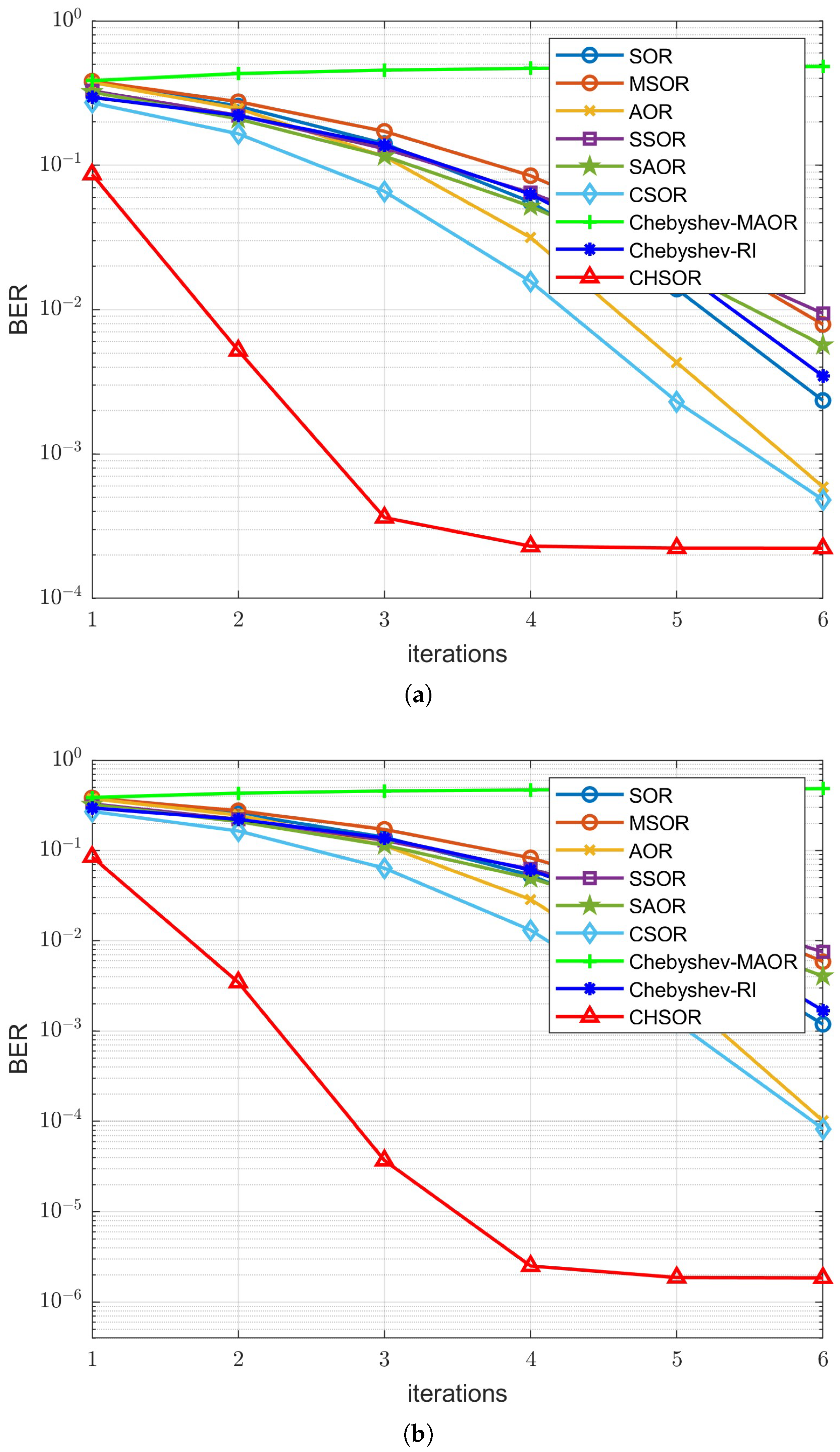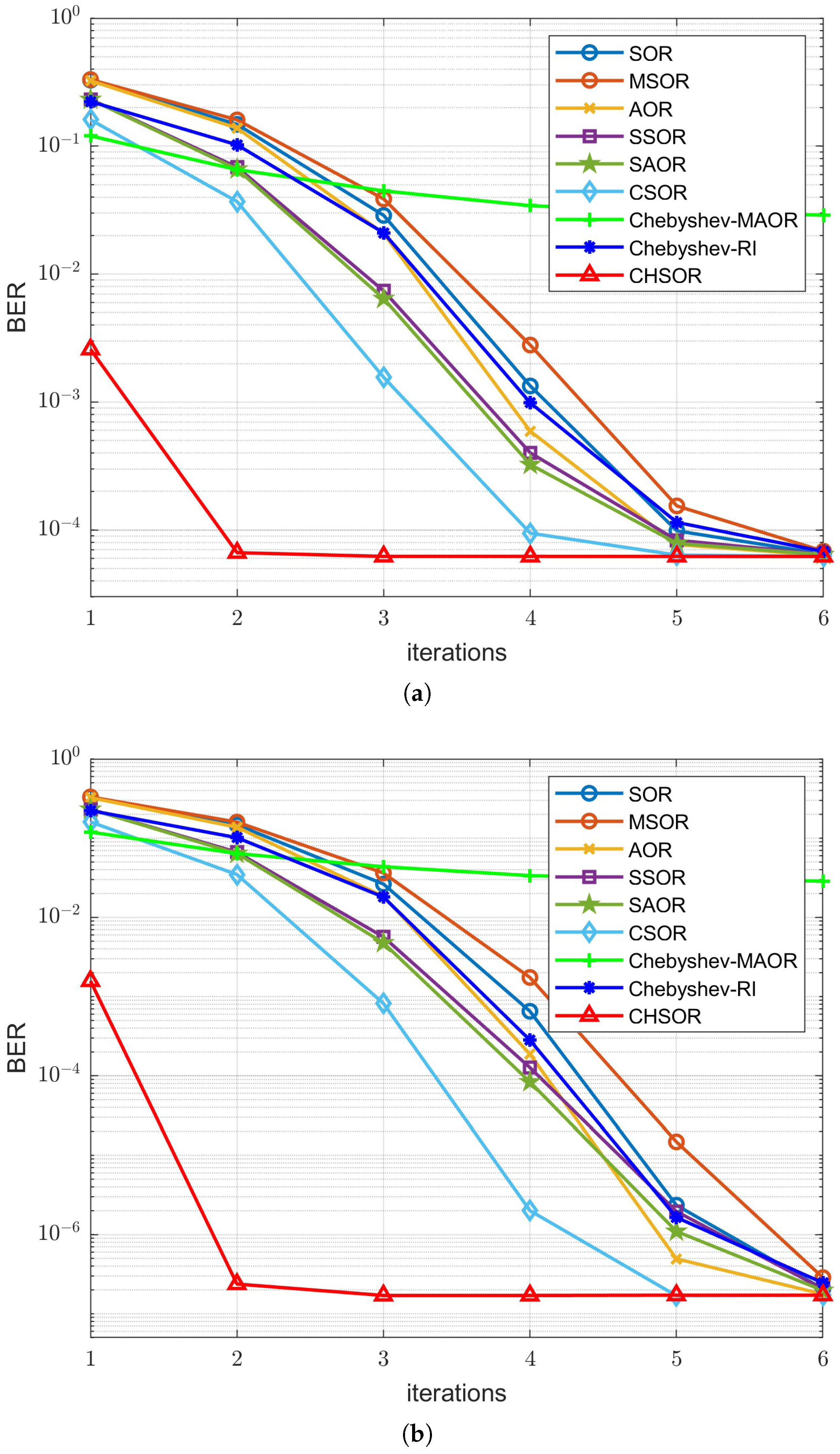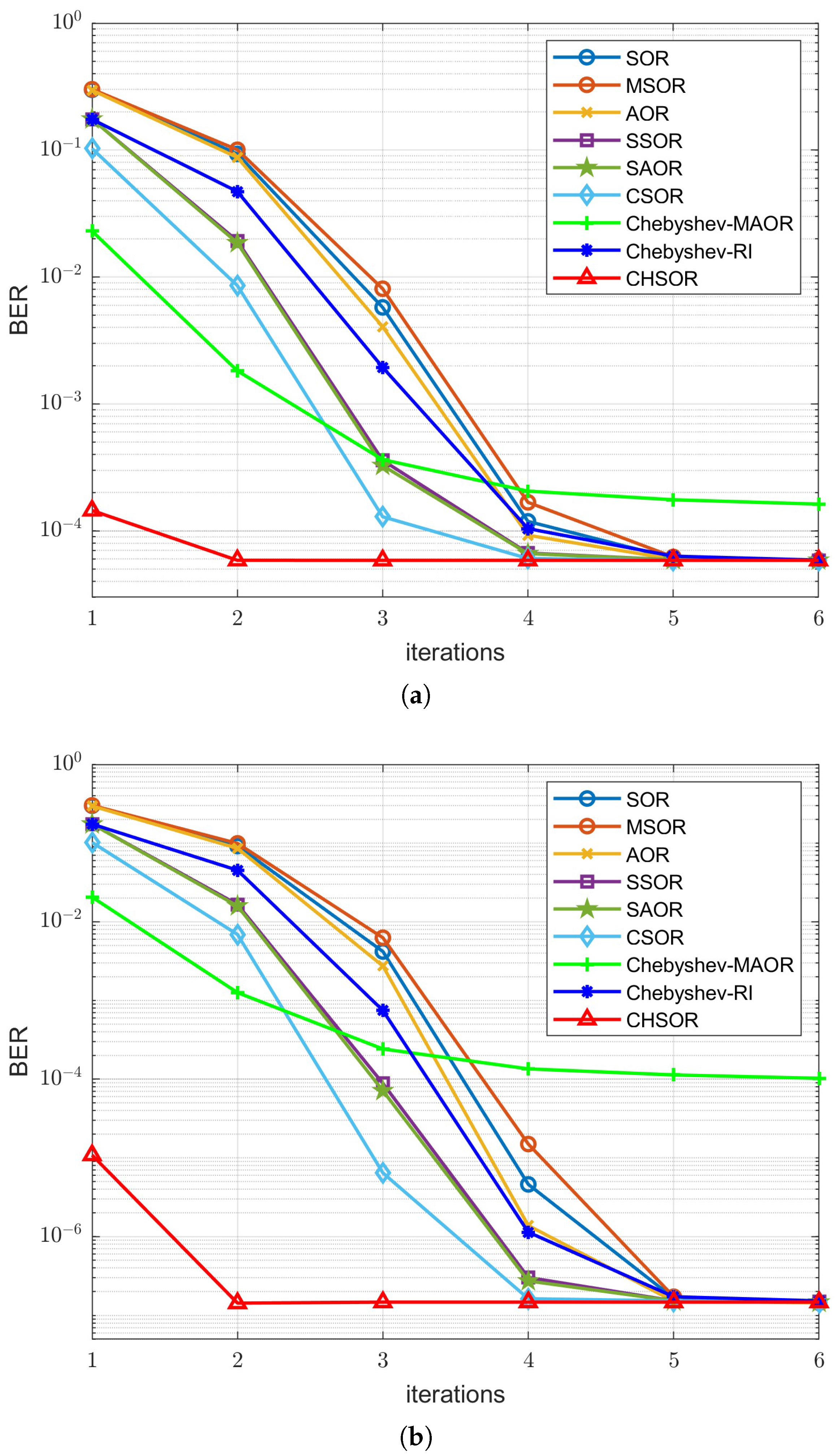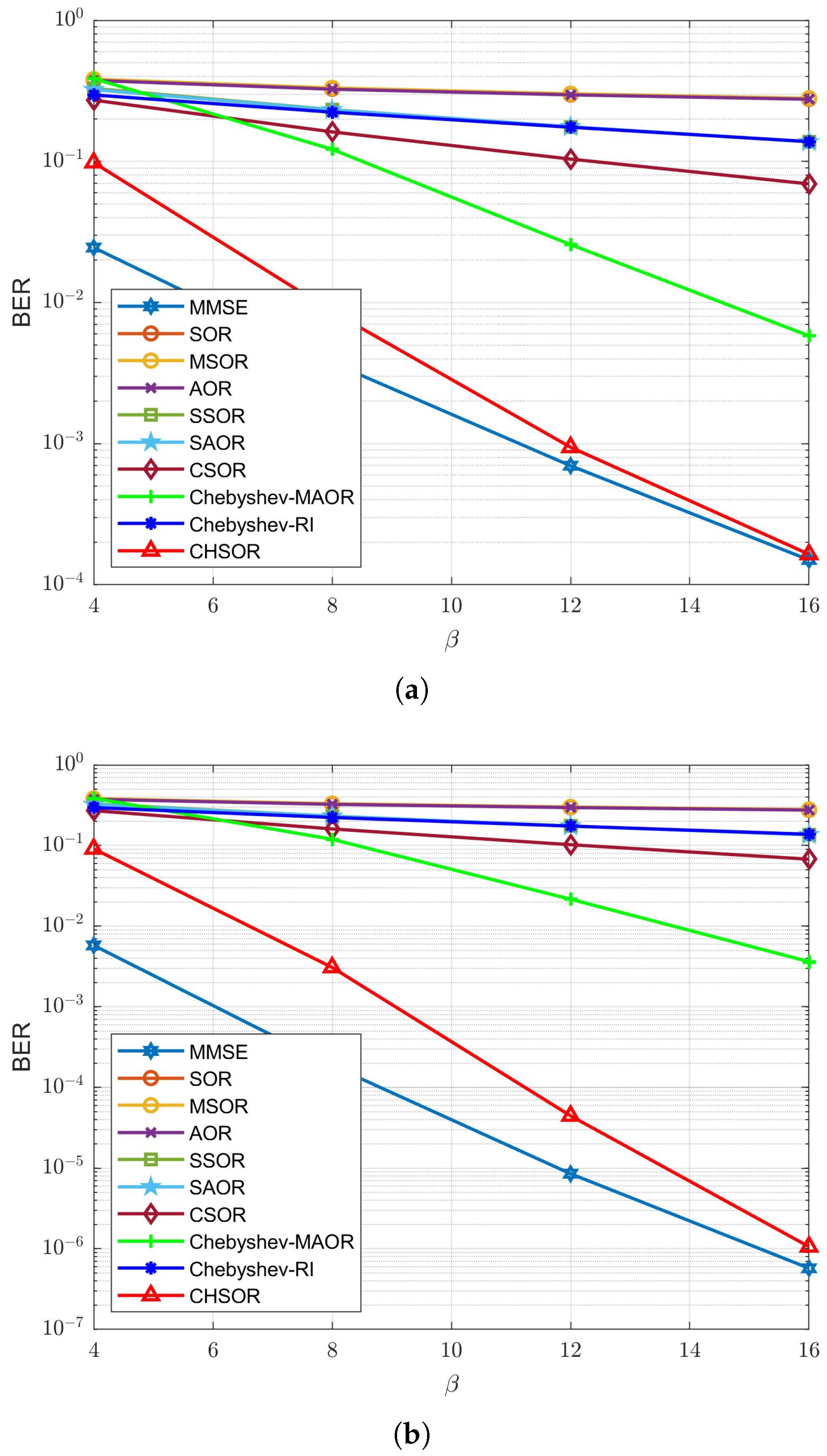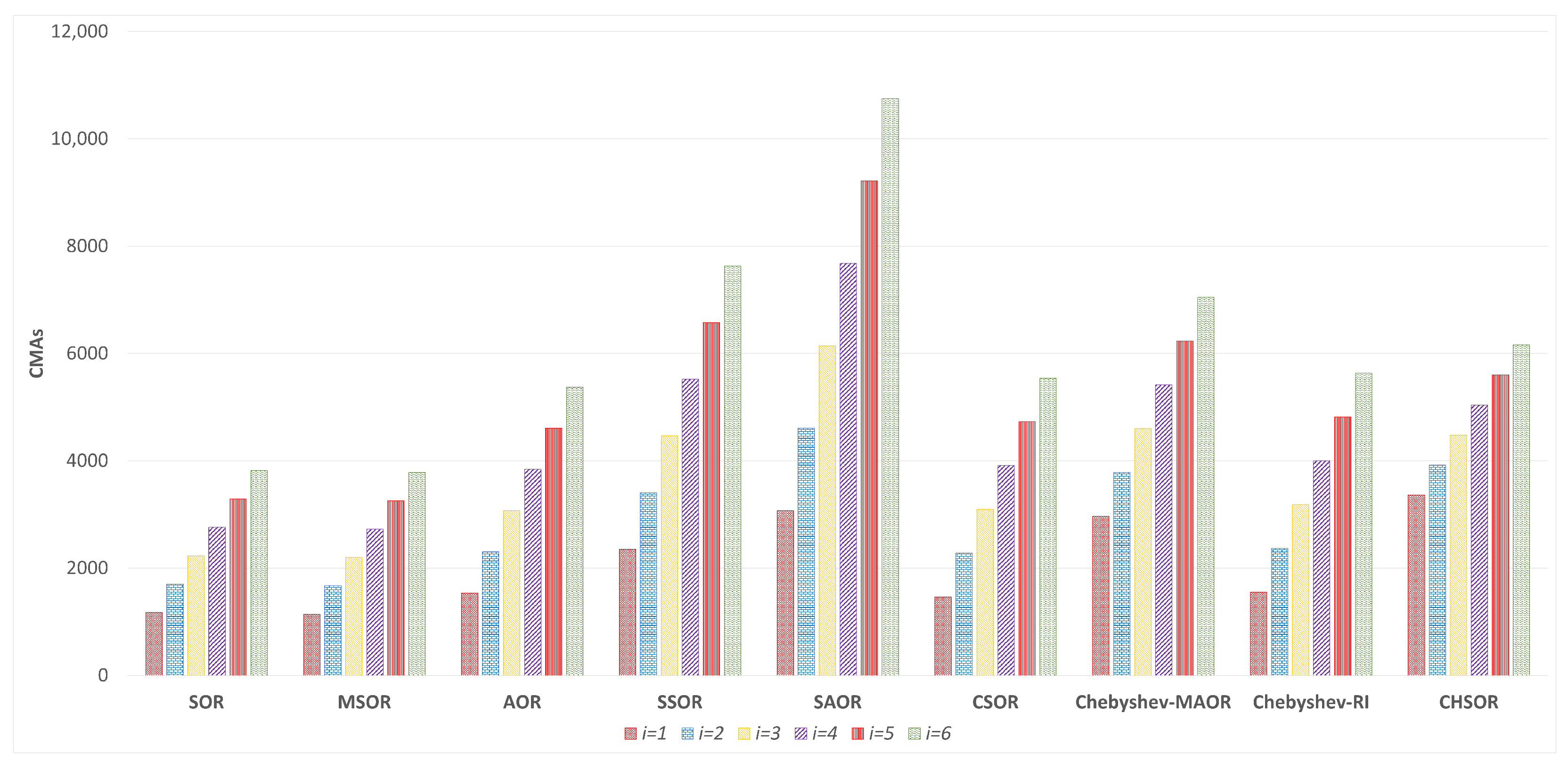4.1. Simulation Results and Discussion
In this section, we follow the multi-user uplink M-MIMO environment illustrated in
Section 2 to perform numerical simulations with OFDM and UFMC waveforms in order to evaluate and verify the performance of our proposed CHSOR receiver. The number of subcarriers of OFDM is set to be equal to the amount of data (512). In addition, it is necessary to add a CP with a length of 128, i.e., a quarter of the number of subcarriers, and 52 pilot data in one symbol. For UFMC, we set the number of subcarriers to 1024 and the total data volume to 512. This is divided into
sub-bands, each with
data. With these settings, 256 zeros must be padded at the head and the tail of the symbol to account for the difference between the number of subcarriers and the amount of data. For the filter type, we adopt a Chebyshev FIR filter [
57,
58] with a length of 43 and a side attenuation of 40 dB. To assess the impact of antenna configuration on performance, we set the number of transmit antennas
to 16 and the number of receive antennas
to 64, 128, 192, and 256. To facilitate further analysis, we used the parameter
as the ratio of the receiving to transmitting antennas, or antenna ratio, denoted as
[
50,
59]. In terms of channels, we established two flat Rayleigh fading channels with additive white Gaussian noise (AWGN). The maximum signal-to-noise ratio (SNR) for these channels was set at 50 dB and least-squares (LS) estimation was used to obtain the channel state information (CSI). For clarity, the above experimental parameters are tabulated in
Table 2.
The following experiments were applied to the OFDM and UFMC waveforms. Our proposed CHSOR scheme is compared with nine detectors, including SOR [
17], MSOR [
19], AOR [
18], SSOR [
20], SAOR [
21], CSOR [
22], Chebyshev-MAOR [
27], Chebyshev-RI [
26], and MMSE, with the MMSE scheme used as a benchmark. The MATLAB version R2022a mathematical software tool was used to simulate the numerical results and graphics. We executed 500,000 Monte Carlo rounds for each graph and used Microsoft Excel for the calculations and statistical tables.
To observe which of UFMC and OFDM is more suitable for B5G and future communication environments, we used BER performance and power spectral density (PSD) indices to make an intuitive comparison.
Figure 7 shows the BER vs. SNR for both waveforms detected using MMSE when
. It can be seen that UFMC is better than OFDM; when the SNR is 35 dB, the BER of OFDM and UFMC are
and
, respectively, which is a
improvement. On the other hand, the PSD comparison in
Figure 8 shows that the power sidelobe level of the OFDM waveform is larger than that of the UFMC waveform, indicating higher out-of-band emission and a tendency towards ACI. Therefore, we observe that the UFMC waveform has higher spectral efficiency and can better suppress the occurrence of ACI. In summary, the UFMC waveform is superior to the OFDM waveform regarding both BER performance and PSD, and is a promising B5G candidate waveform in future applications.
For BER performance,
Figure 9,
Figure 10,
Figure 11 and
Figure 12 show the BER vs. SNR curves of each method under different antenna configurations;
Figure 9a,
Figure 10a,
Figure 11a and
Figure 12a show the results for OFDM, while
Figure 9b,
Figure 10b,
Figure 11b and
Figure 12b show the results for UFMC. It is worth noting that the BER of the Gauss-Seidel (GS) and Conjugate-Gradient (CG) methods in
Figure 9 and
Figure 10 is relatively poor when the number of receive antennas
is 64 and 128; thus, better performance at higher
is unlikely. Based on these results, GS and CG are excluded from the subsequent figures for visual conciseness and to avoid clutter. On the other hand,
Figure 9a,b shows that when
and the number of iterations is 4, the BER performance curves of the proposed CHSOR method almost overlap with the MMSE detector. In particular, in
Figure 9a for the OFDM system, when the SNR is 35 dB, the BER numerical results of the proposed and CSOR methods are
and
, respectively, which is an improvement of
. For the UFMC system in
Figure 9b, the results show that the BER of the proposed and CSOR methods are
and
, respectively, which is an improvement of
. Therefore, the proposed CHSOR detector provides a significant improvement compared to the CSOR method, especially for the UFMC system.
To observe the impact of M-MIMO on the BER performance of different detectors, we increased the number of receiving antennas from 128 to 192, and then to 256, as shown in
Figure 10,
Figure 11 and
Figure 12, respectively. Our proposed CHSOR detector still provides superior BER performance compared to the others. It is worth mentioning that when the number of receiving antennas is 128, the BER performance curve of the proposed CHSOR method remains very close to the MMSE detection method after two iterations. When the number of antennas
is increased to 192 and then again to 256, the BER performance of our proposed CHSOR method still maintains the same trend, only needing one iteration for both OFDM and UFMC. It can be seen that increasing the number of receiving antennas can speed up the convergence of the receiver without exception. These represent promising results for the application of M-MIMO to B5G applications.
For more clarity,
Table 3 enumerates the detailed BER results of the proposed CHSOR scheme and the Chebyshev-MAOR scheme. The improvement rate of the proposed CHSOR scheme is compared to the Chebyshev-MAOR scheme at SNR = 30 dB for
and
under both the OFDM and UFMC systems. Examining the numerical data in the CHSOR scheme in
Table 3. when
increases, in addition to the decrease in BER and enhancement of the improvement rate relative to other detectors, the application of UFMC for B5G systems is especially powerful.
According to the discussion in
Section 3, convergence means that the signal vector gradually tends to a stable state after iteration; in other words, the BER reaches a stable value when the state no longer changes. To facilitate subsequent discussion, we define a convergence parameter that we call the BER altered rate
for each iteration, as follows:
where
represents the BER obtained at the
iteration and
represents the altered rate in BER between the current iteration and the next iteration. In this paper, without loss of generality, we select a small enough
variation of 1%; therefore, the iteration schemes can be convergent as long as they meet the following conditions:
To verify and compare the iteration convergence among all detectors in this study, we enumerate the BER altered rate for each iteration in
Table 4,
Table 5,
Table 6 and
Table 7 and plot the convergence curve in
Figure 13,
Figure 14,
Figure 15 and
Figure 16 with antenna configurations of
,
,
, and
, respectively. For
Figure 13, the antenna configuration
is
and the SNR is 37 dB, in which
Figure 13a,b show the experiments conducted with the OFDM and UFMC systems, respectively. From the overall numerical analysis and observation of
Table 4 and
Figure 13a, it can be seen that the CHSOR method always performs the best and converges within five iterations. Compared to the second-best performing CSOR method, the BER improves by
. The results for the UFMC system are shown in
Figure 13b. When the number of iterations is 5, the BER performance of the CHSOR method is improved by
compared with the CSOR method. When the
is increased to 128 and the SNR is 34 dB, the proposed method converges in three iterations, while the other methods fail to converge even after five iterations. The simulation results for
increased to 192 and SNR of 32 dB are shown in
Figure 15a,b for the OFDM and UFMC systems, respectively. Similar to the results for
of 128,
Table 6b shows that the proposed method converges in three iterations for UFMC; furthermore,
Table 6a shows that CHSOR converges after just two iterations for OFDM. When the number of iterations is 2, the proposed scheme has an improvement rate of
and
over Chebyshev-MAOR in the OFDM and UFMC systems, respectively. While CHSOR already demonstrates near-MMSE performance with only two iterations at
of 192, its advantage becomes even better when the number of antennas is further increased to 256. As shown in the BER vs. iteration curves in
Figure 16, the line for the CHSOR scheme is almost flat for both OFDM and UFMC systems, indicating that the proposed method converges almost within one iteration. With a large enough number of antennas, such as 192 or 256, it can significantly aid the HSOR stage to reduce the burden on the Chebyshev stage. In contrast, although Chebyshev-MAOR remains the fastest among the other methods, it still requires 3–4 iterations to reach a similar BER level, as evidenced in
Table 7.
In summary, among the related detectors discussed in this paper, our proposed CHSOR algorithm has fast convergence speed and presents the best BER performance. Moreover, the experimental results in
Figure 13,
Figure 14,
Figure 15 and
Figure 16 and
Table 4,
Table 5,
Table 6 and
Table 7 along with
Appendix A theoretically prove the convergence of the proposed scheme and verify convergence from the obtained experimental data.
To analyze the BER performance of different detectors varies with different ratios of
to the total number of user antennas
, we denote this as
, or the antenna ratio [
50,
59].
Figure 17 and
Figure 18 show the results of the experiments with one and two iterations, respectively, when the SNR is 30 dB. In
Figure 17, it can be seen tht when the antenna ratio is low, no method can achieve the BER performance of MMSE with one iteration. As
increases, the BER of the proposed CHSOR scheme decreases significantly and gradually approaches the MMSE detector. Even though the BER of other methods also improves, the declining trend is quite slow compared with our CHSOR scheme. When
is equal to 16, the CHSOR scheme is remarkably close to the MMSE detector. Next, the results with two iterations are shown in
Figure 18. Compared with
Figure 17, the BER performance of each method improves, but all are still inferior to our proposed method. Moreover, the curve of the CHSOR method almost coincides with the MMSE curve at any antenna ratio
.
To show the performance differences more intuitively, we enumerate the BER differences between each method and the MMSE detector under the same conditions in
Table 8 and
Table 9 based on
Figure 17 and
Figure 18.
Table 8a for the OFDM system shows that when
is 12 and 16, the distances are
and
, respectively.
Table 8b for the UFMC system shows that when
is 12 and 16, the gap can be reduced to
and
, respectively. Moreover, when the number of iterations is 2 and with a sufficiently high
, the gap between our method and MMSE can be reduced to approximately order
for both the OFDM or UFMC systems, as enumerated in
Table 9.
Thus far, the discussion on the impact of the number of receive antennas and antenna ratios on the uplink receiver of the BER performance has been well established. Due to the advantage actuated by the spatial diversity gain of massive antennas, as long as the antenna ratio becomes higher, the BER of any method will decrease without exception. It is worth noting that the effect is particularly significant for our proposed CHSOR scheme. Moreover, this performance echoes what was inferred earlier; when increases, BER performance can be improved and convergence acceleration can be achieved with reduced complexity. This means that the experimental results are reasonable and confirms that the proposed method can adequately and efficiently utilize the spatial diversity gain, resulting in performance quite close to that of the MMSE baseline. Moreover, the sensitivity of different schemes to the number of antennas is also worth observing and discussing. For instance, Chebyshev-MAOR exhibits strong dependence on the number of antennas. Its performance degrades considerably under low antenna ratio MIMO configurations, such as , and only shows good results when the number of receiving antennas is high enough, such as . On the other hand, for Chebyshev-RI the performance improvement remains marginal even when the number of antennas increases. In contrast, the proposed CHSOR method demonstrates robust and consistent performance across various antenna settings. CHSOR remains stable and effective regardless of whether the antenna ratio is low or high, highlighting its superior adaptability and reliability in M-MIMO systems.
